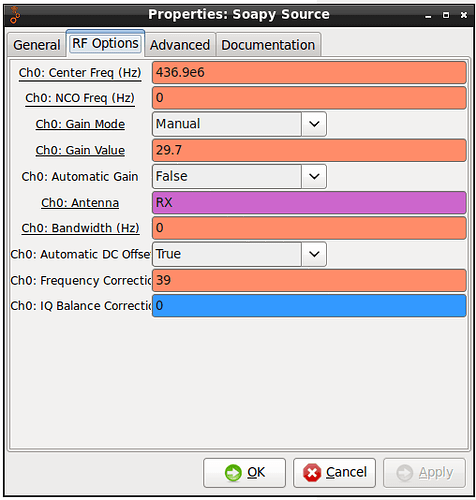The SATNOGS_PPM_ERROR option have no effect on the latest version of the SatNOGS client system. Previously had the opportunity to pass parameters for librtlsdr using the --dev-args ( SATNOGS_DEV_ARGS ).
Below is a screenshot for setting the Soapy Source radio parameters in Gnuradio flowgraph.
As you see, Soapy Source block have special setting 'Freq Correction" ( it works! ). The following code corresponds to it:
self.soapy_source_0 = \ soapy.source(1, 'rtlsdr', '', samp_rate*40, "fc32") self.soapy_source_0.set_frequency(0, 436.9e6) self.soapy_source_0.set_gain_mode(0, False) self.soapy_source_0.set_antenna(0, 'RX') self.soapy_source_0.set_dc_offset_mode(0, True) self.soapy_source_0.set_frequency_correction(0, 39)
SoapySDRUtil application allow to print information about the RTL-SDR.
You can see parameter:
Freq Correction [corr]: Default 0 (parts per million)
Unfortunatelly, parameter corr in SATNOGS_DEV_ARGS have no effect also (see dev_args: “corr=37” in Metadata>radio ).
Here information for my RTLSDR:
######################################################
Soapy SDR – the SDR abstraction library
######################################################
Probe device driver=rtlsdr
– Device identification
driver=RTLSDR
hardware=UNKNOWN
index=0
origin=GitHub - pothosware/SoapyRTLSDR: SoapySDR RTL-SDR Support Module
– Peripheral summary
Channels: 1 Rx, 0 Tx
Timestamps: YES
Time sources: sw_ticks
Other Settings:
* Direct Sampling - RTL-SDR Direct Sampling Mode
[key=direct_samp, default=0, type=string, options=(0, 1, 2)]
* Offset Tune - RTL-SDR Offset Tuning Mode
[key=offset_tune, default=false, type=bool]
* I/Q Swap - RTL-SDR I/Q Swap Mode
[key=iq_swap, default=false, type=bool]
* Digital AGC - RTL-SDR digital AGC Mode
[key=digital_agc, default=false, type=bool]
– RX Channel 0
Full-duplex: NO
Supports AGC: YES
Stream formats: CS8, CS16, CF32
Native format: CS8 [full-scale=128]
Stream args:
* Buffer Size - Number of bytes per buffer, multiples of 512 only.
[key=bufflen, units=bytes, default=262144, type=int]
* Ring buffers - Number of buffers in the ring.
[key=buffers, units=buffers, default=15, type=int]
* Async buffers - Number of async usb buffers (advanced).
[key=asyncBuffs, units=buffers, default=0, type=int]
Antennas: RX
Full gain range: [0, 0] dB
TUNER gain range: [0, 0] dB
Full freq range: [23.999, 1764] MHz
RF freq range: [24, 1764] MHz
CORR freq range: [-0.001, 0.001] MHz
Sample rates: 0.25, 1.024, 1.536, 1.792, 1.92, 2.048, 2.16, 2.56, 2.88, 3.2 MSps
Perhaps SATNOGS_PPM_ERROR is still required?
